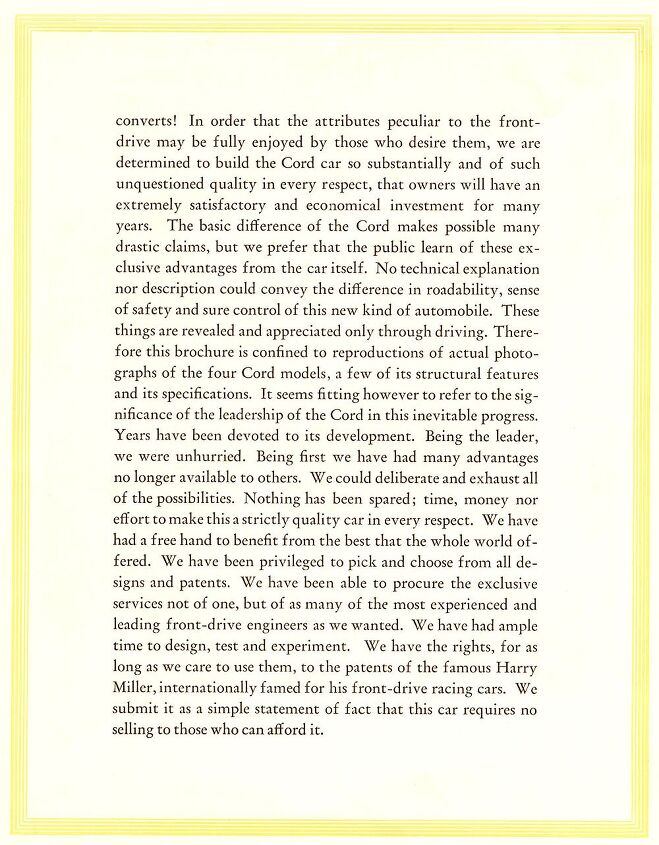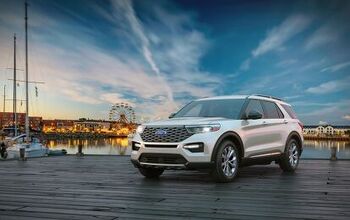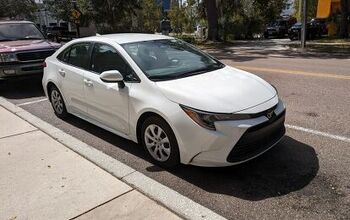Antique Auto Advertising: Why We Introduce A Front Drive Automobile by E. L. Cord

When you say the word Cord, most car enthusiasts think of the “coffin nose” 810/812 models, designed by Gordon Buehrig for the 1936 and 1937 model years. There was much about the ’36-’37 Cords that was revolutionary, or at the very least advanced for their day. Buehrig’s art deco masterpiece was E. L. Cord’s automotive swan song. His styling included hideaway headlights flush mounted in pontoon fenders, hidden door hinges, no running boards, and that distinctive one piece hood was hinged at the cowl and opened from the front, not from the sides as in most prewar cars. From a technical standpoint, what people remember about the ’36 Cord is that it had front wheel drive. Some mistakenly believe that the Cord 810 was the first front wheel drive American production car. Actually, the first front wheel drive Cord was the L-29, named for 1929, its year of introduction. The L-29 was not just the first Cord with front wheel drive, it was indeed the first American car with front wheel drive that was offered for sale to the public, beating the now obscure Ruxton to the market by a few months.
1929 Cord L-29. It sits lower than the 1940 Ford next to it. More photos here.
The Ruxton is best remembered for its stylish but ineffective Woodlight headlamps. Pretty much nobody then knew who Ruxton was (the company was named to entice a potential investor, who demurred but by then the name had ironically stuck) but by 1929 plenty of people knew who E.L. Cord was. Errett Loban Cord was a savvy businessman, a wheeler dealer, a pioneer in a variety of industries and the father of some of the greatest automobiles ever made.
A racecar driver and mechanic and then a successful car salesman, he was brought in by Auburn in 1924 to help turn the moribund company around. By 1928 he owned Auburn, part of a growing empire that eventually included Duesenberg, Lycoming Engines, Stinson Aircraft, radio stations, the predecessor of American Airlines, and for a while the Checker Cab and Checker Motor companies (which got him into trouble with the Securities and Exchange Commission).
For 1929, Cord decided to launch his self-named brand to slot in between the supremely patrician Duesenberg and the slightly more plebeian (but still not cheap) Auburns. Racing legend Harry Miller had already demonstrated the promise of front wheel drive on the racetrack. E.L. Cord realized that FWD had some advantages for road cars as well so he had Cornelius Van Ranst design a front drive layout based on Miller’s patents, using a straight eight Lycoming engine sitting behind the gearbox with a De Dion axle and inboard drum brakes up front.
Cornelius Van Ranst designed the Cord FWD layout based on Harry Miller’s patents. More pics here.
By eliminating the need for a driveshaft to the back axle, the engine and transmission could sit low in the chassis, allowing not just a lower center of gravity but also letting the body sit lower to the ground. The long drivetrain meant that stylist Alan Leamy could give the L-29 an exceptionally long hood. Leamy used the long hood and the low body to give the car a rakish and very sporting look, not unlike chopped and channeled hot rods.
The L-29 was not a huge success, having the misfortune of being introduced a few months before the stock market crashed and the Great Depression was triggered. It also was heavy, slow, and had some reliability issues, so only a few thousand were made and sold, ending production in 1932. Still, the L-29 remains the first American production car to offer front wheel drive and it continues to be a great looking car, timelessly rakish and sporting.
Architect Frank Lloyd Wright’s L-29 in his signature Taliesin Orange color. More pics here.
To promote the then revolutionary layout, the Auburn Automobile Company published a 15 page brochure with technical drawings of the chassis, photos of the L-29 with various body styles in locations in what I believe was southern California, extensive technical specifications and about two pages of advertising copy, attributed to E. L. Cord himself, titled Why We Introduce A Front Drive Automobile.
It’s fun to watch Cord (or whoever wrote the text) try to tout FWD as the latest and greatest while insisting that the traditionally laid out Auburns and Duesenbergs were not being made obsolete by his company’s new brand. In many ways, the brochure isn’t that much different than what you’d see today, though a modern advertisement is not likely to start out with two pages of text from the company founder.
Ronnie Schreiber edits Cars In Depth, a realistic perspective on cars & car culture and the original 3D car site. If you found this post worthwhile, you can dig deeper and get a parallax view at Cars In Depth. If the 3D thing freaks you out, don’t worry, all the photo and video players in use at the site have mono options. Thanks for reading– RJS

Ronnie Schreiber edits Cars In Depth, the original 3D car site.
More by Ronnie Schreiber
Latest Car Reviews
Read moreLatest Product Reviews
Read moreRecent Comments
- MaintenanceCosts Poorly packaged, oddly proportioned small CUV with an unrefined hybrid powertrain and a luxury-market price? Who wouldn't want it?
- MaintenanceCosts Who knows whether it rides or handles acceptably or whether it chews up a set of tires in 5000 miles, but we definitely know it has a "mature stance."Sounds like JUST the kind of previous owner you'd want…
- 28-Cars-Later Nissan will be very fortunate to not be in the Japanese equivalent of Chapter 11 reorganization over the next 36 months, "getting rolling" is a luxury (also, I see what you did there).
- MaintenanceCosts RAM! RAM! RAM! ...... the child in the crosswalk that you can't see over the hood of this factory-lifted beast.
- 3-On-The-Tree Yes all the Older Land Cruiser’s and samurai’s have gone up here as well. I’ve taken both vehicle ps on some pretty rough roads exploring old mine shafts etc. I bought mine right before I deployed back in 08 and got it for $4000 and also bought another that is non running for parts, got a complete engine, drive train. The mice love it unfortunately.


























































Comments
Join the conversation
Great article, and so are the knowledgeable comments from TTAC readers filling in the blanks on FWD history.
This excellent article is tangentially related: http://studebaker-info.org/Indy/NOvi/Novi1b.html I had no idea that they were racing FWD (then AWD) cars into the 1960s. I still remember visiting the Indianapolis Raceway Museum and seeing one of the FWD Indy cars back in 1985. I had no idea that they had ever raced FWD vehicles before that. It's remarkable that it took so long for the concept to become mainstream.